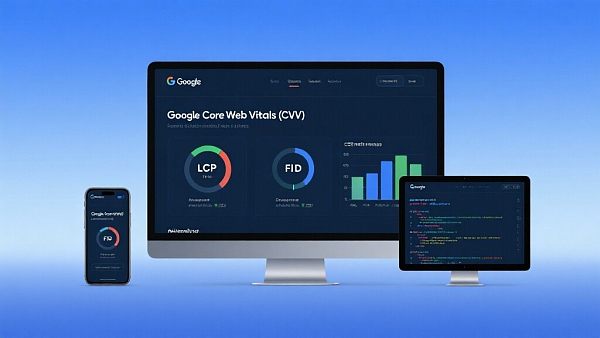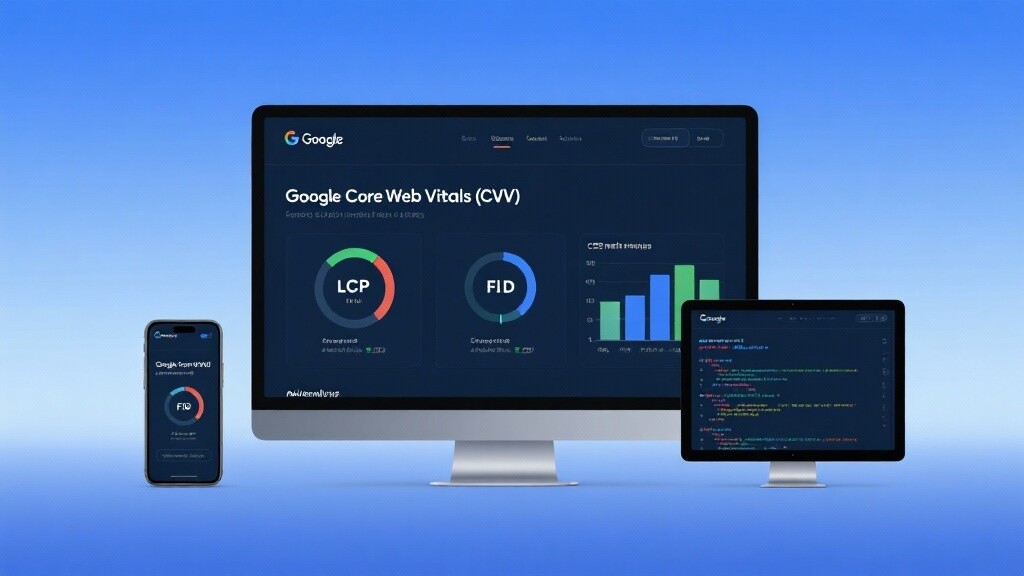I. The authoritative definition and core value of responsive website SEO optimization
1. The authoritative definition of Responsive Web Design (RWD)
A **responsive website** is a website designed and developed to automatically adjust its layout, image size, and content display on different devices (such as desktop computers, tablets, and smartphones) to provide the best user experience. Its core technology lies in using **CSS Media Queries** to flexibly adapt and adjust content based on the device's screen size, resolution, and orientation.
2. Core Definition of Responsive Website SEO Optimization
**Responsive website SEO optimization** is a systematic strategy that ensures responsive design not only adapts to various devices but also **100% complies with all technical requirements of Google Mobile-First Indexing and Core Web Vitals (CWV)**, thereby achieving top rankings across all search results. This places particular emphasis on speed, interactivity, and consistency on mobile devices.
3. The 4 Core Values of Responsive SEO Optimization
II. The Development History of Responsive Website SEO Optimization Strategies: From Adaptive to Core
The evolution of responsive design and its SEO strategies is closely linked to the rise of mobile internet and changes in Google's algorithm. This reflects a complete shift in SEO from desktop to mobile.

1. Phase One: The Era of Mobile Sites and Decoupled URLs (2007-2012)
Model characteristics: Enterprises create a separate subdomain or subdirectory for mobile devices (e.g., `m.example.com`). SEO pain points: Requires handling complex **`rel=canonical` and `rel=alternate` tags** to tell Google the correspondence between desktop and mobile pages, **resulting in **distributed link weight and extremely high maintenance costs**.
2. Phase Two: The Birth of Responsive Design and Google's Official Recommendation (2012-2016)
Milestones: Ethan Marcotte introduced the concept of Responsive Design (RWD) in 2010, and Google officially recommended responsive design as a **mobile-friendly best practice** in 2012. Strategic Transformation: SEO began to simplify as a single URL eliminated a significant amount of repetitive technical work. However, optimization focused on fundamental mobile-friendliness aspects such as **viewport configuration** and **touch target size**.
3. Phase Three: Mobile-First Indexing and the Core of SEO in the CWV Era (2016-Present)
Key changes: In 2016, Google announced **mobile-first indexing**, and in 2021, it launched **Core Web Vitals (CWV)** ranking signals. Trend: The focus of responsive SEO has shifted from "design adaptation" to "performance optimization." The key is to ensure that mobile loading speed (LCP), interactivity (FID), and visual stability (CLS) **100% meet Google's compliance standards**.
III. The Fundamental Principles of Responsive Website SEO Optimization: 5 Key Techniques
Professional **responsive website SEO optimization** relies on the following 5 core technical principles to ensure your website gains an advantage in Google's algorithm:
1. Core Web Vitals (CWV) speed optimization principles
Principle: CWV measures three key dimensions of user experience (LCP, FID, CLS). **Mobile performance is typically the lowest, making it crucial for optimization.** Technical Implementation: **Prioritize loading critical CSS and HTML**, and lazy load non-first-screen images and videos. Optimize image formats (e.g., WebP) to **ensure LCP (Maximum Content Render Time) is under 2.5 seconds.**
2. Client-Side Adaptability Principle
Principle: Utilizing browser-side CSS media queries, rather than server-side redirects, to adapt to different devices. Technical Implementation: Correctly configuring the **Viewport Meta tag** within the `<head>` tags. This ensures that the browser knows how to adjust the content width. This is the foundation of responsive SEO.
3. Content Parity & Crawlability
Principle: Under mobile-first indexing, Google only crawls mobile content. If the mobile version hides the desktop content, that content will not be indexed. Technical implementation: **Ensure that all important content, H tags, internal links, and structured data are 100% present in the mobile HTML code**, even if hidden via CSS (such as the desktop sidebar).
4. Image Response Optimization Principles (Responsive Images & Sources)
Principle: To avoid loading excessively large desktop images on mobile devices, thus wasting bandwidth. Technical Implementation: Using the `srcset` attribute or...
5. Principles of Structured Data and Mobile Compatibility
Principle: Structured data (Schema Markup) helps Google better understand page content, but it's crucial to ensure correct rendering on mobile devices. Technical Implementation: Use **JSON-LD format** and ensure all elements implementing structured data (such as reviews and prices) are visible and easily interactive on mobile devices.
IV. Four Core Features and Application Practices of Responsive Website SEO Optimization
1. Core characteristic: Technical complexity is concentrated in the front end.
Features: The main challenge of responsive SEO lies in the loading and execution efficiency of CSS and JavaScript, especially CWV optimization. Applications: Professional SEO companies perform in-depth **CSS/JS minimization, code splitting, and tree shaking** to **significantly improve mobile performance scores**.
2. Core Feature: High Reliance on Tool-Based Diagnostics
Features: CWV (Content Value) cannot be determined visually. Applications: **100% reliant on mobile usability reports from Google PageSpeed Insights, Lighthouse, and Google Search Console.** SEO strategies must be iterated upon based on data feedback from these official tools.
3. Application Practice: Foreign Trade E-commerce Websites
Practice: Mobile traffic typically accounts for up to 70% of cross-border e-commerce traffic. The key to **responsive SEO optimization** is to **ensure that the product page's LCP loads extremely quickly** and optimize the FID (First Input Delay) of the mobile checkout process, **directly improving mobile conversion rates**.
4. Application Practice: Content-based Portal Website
In practice: The key to content-based websites is **CLS (Cumulative Layout Offset) optimization** to prevent page jumps caused by ad or image loading, which severely impacts the user's reading experience. **Responsive SEO** requires ensuring that all ad placements and media elements have sufficient space (`aspect-ratio`).
V. Responsive SEO Optimization Practical Process and Quantitative ROI Prediction
A successful **responsive website SEO optimization** project must follow a scientific, CWV-centric process and be able to clearly predict its return on investment (ROI).

1. 6-Step Responsive SEO Optimization Process
- **Phase 1: CWV Baseline Testing and Diagnosis:** Use Google's official tools to obtain initial scores for mobile LCP, FID, and CLS to pinpoint core bottlenecks.
- **Phase 2: Technical Architecture Audit:** Check whether the Viewport configuration, content consistency, Hreflang, and other SEO infrastructure settings are 100% compliant.
- **Phase 3: Front-end performance optimization (CWV core):** Perform image optimization, resource compression, lazy loading, etc., to improve the mobile score to the "good" zone.
- **Phase 4: Mobile UX/UI Interaction Optimization:** Ensure the target size is appropriate to avoid **accidental clicks**, and optimize form input latency (FID).
- **Phase 5: Deployment of Structured Data and AMP Strategy:** Deploy or verify the consistency of Schema Markups on mobile devices, and deploy AMP on demand.
- **Phase 6: Continuous Monitoring and Iteration:** Monitor actual user data (CrUX reports) through the Search Console, conduct A/B testing, and perform continuous optimization.
2. Quantifying ROI Prediction: The Business Value of Responsive SEO
The return on investment in **responsive website SEO optimization** is direct and quantifiable:
- **Ranking Improvement:** Websites that meet CWV standards enjoy an advantage in Google rankings. **Core keyword rankings improve by an average of 15% to 30%.**
- **Traffic Growth:** Mobile traffic can increase by 50% to 100% after optimization, especially in industries with fierce competition in mobile search.
- **Conversion Rate Improvement:** A 0.1-second improvement in LCP can increase mobile conversion rates by 8%. Overall conversion rate improvement is over 15%.
- **Operational cost savings:** The unified responsive design reduces the complexity of content management and technical maintenance, **saving over 30% in maintenance costs.**
VI. YiYingBao: Your Leading Expert in Responsive Website SEO Optimization
Is your website falling behind in Google mobile rankings? EasyPro offers a **100% CWV-based responsive website SEO optimization solution.** Through in-depth technical audits and front-end code optimization, we **ensure your website's mobile performance metrics meet Google's "Good" standard**, helping you truly win in the mobile-first era. **Stop wasting your desktop optimization efforts and focus on mobile now!**
Get a free in-depth CWV diagnostic report for responsive websites!FAQ
1. What are the Core Web Vitals (CWV) compliance standards for responsive website SEO optimization?
Answer: CWV has 3 core metrics: LCP (Largest Contentful Paint) must be less than 2.5 seconds; FID (First Input Delay) must be less than 100 milliseconds; CLS (Cumulative Layout Shift) must be less than 0.1. **All metrics must meet the "Good" standard on mobile** to receive Google's page experience ranking boost.
2. What are the differences between responsive websites and adaptive websites in SEO optimization?
Answer: **Responsive (RWD)** uses CSS media queries with **a single URL**, strongly recommended by Google, making SEO maintenance simplest. Adaptive Design provides **different preset layouts** based on device types, usually still with a single URL, but less flexible and maintainable than RWD. Responsive SEO optimization focuses more on front-end performance and fluidity.
3. How to ensure my mobile content is not hidden or ignored by Google?
Answer: The key is content consistency. Use Google Search Console's "Mobile Usability" tool and **URL Inspection Tool** to view mobile-rendered pages from Googlebot's perspective. **Ensure all desktop-important content, links, and structured data 100% exist in mobile HTML**, even if it's hidden via CSS folding.
4. Is Lazy Loading good or bad for responsive website SEO optimization?
Answer: Lazy loading is **a key technology for improving CWV performance (especially LCP)**. Correct usage (only for non-hero images and iframes) can significantly accelerate above-the-fold loading. But note: **Never lazy-load LCP elements**, and must reserve space for lazy-loaded elements to avoid CLS layout shifts.

Customer Reviews
Mr. Chen, CEO of a Cross-border B2B Trading Company
"Our responsive website ranked well on desktop, but mobile traffic stagnated. EasyWin's **responsive website SEO optimization** team conducted professional CWV audits. **Through critical CSS optimization and responsive image processing, they improved our mobile LCP score by 1.2 seconds**. The results were astounding: **Within 90 days, mobile traffic and inquiries doubled with 80% growth**. This proves only professional SEO agencies can solve such fundamental performance issues."
Ms. Lin, Market Director of a Domestic E-commerce Platform
"E-commerce fears page jumps and slow loading most. We struggled with CLS layout shifts. EasyWin's **responsive website SEO optimization** team **successfully reduced CLS to 0** through container reservation for ads and media elements, while optimizing mobile cart page FID. **Our mobile bounce rate dropped 35%**, **directly driving visible conversion rate improvements**. This outperforms any keyword optimization."




